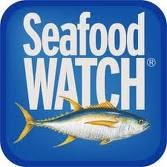
Way back when I first started studying omega-3 chemistry, I put together a list of DHA contents of a variety of seafoods. I was recently asked for a copy of that list, and since the list was not complete the first time I did it, I decided to update it.
I noticed when looking at the latest list that there were two significant changes: Over half of the seafood given the"green light" are farmed. Meaning we need to be more open to eating farmed fish and better manage our ocean farming habits. Secondly, as a consumer it is also important to know what fishing method was used. Some are sustainable, some are not.
The list below is based off of the Monterey Bay Aquarium Seafood Watch list, most recently updated January 11. As much as I advocate for all of you to eat more fish, I want to be sure that I do my part to encourage responsible use of the ocean's resources. So the only options included on this list are the"green light", or most sustainable options. If you don't see it there, it didn't get a green light. The (F) in front of an item denotes"farmed".
I'll update this from time to time so you all can keep current. I used the national list, but you can also find more specific regional lists at the same website. The downloadable wallet cards or iPhone application are great to keep with you so that you can always make better choices when you're grocery shopping or eating out.
Bottom line, any seafood has omega-3's. Even if they're not as high as what is found in salmon, every time you eat fish, you're not eating a meat higher in saturated fat. There's a"double whammy" benefit over and above that simple DHA.
Hope this inspires you to think when buying or ordering your seafood!
Milligrams of EPA/DHA/total omega-3 per 100 gram (3.5 cooked ounces)
(F) artic char 600/500/1100
(F) US barramundi 900/600/1500
(F) US catfish 200/200/400
(F) clams 100/100/200
(F) US cobia 383/418/801
(F) Pacific cod, bottom longline fished 100/100/200
Dungeness/stone crab 100/200/300
Pacific US halibut 300/100/400
Pacific US spiny lobster 100/100/200
(F) mussels 300/200/500
(F) oysters 200/400/600
Alaska sablefish/black cod 100/100/200
Alaskan salmon 575/500/1075
(F) off-bottom scallops 100/100/200
Pink shrimp 100/200/300
(F) striped bass 600/200/800
*striped bass 200/600/800
(F) US tilapia 130/50/180
(F) US rainbow trout 400/100/500
US/British Columbia albacore tuna (canned white) 100/300/400
Skipjack tuna (canned light) 300/100/400